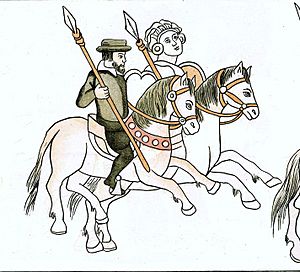María de Estrada facts for kids
María de Estrada (born around 1475 or 1486) was a brave Spanish woman. She joined Hernán Cortés on his journey to Mexico between 1519 and 1524. María was a conquistador, which means she was a Spanish explorer and fighter. She even fought in battles during the conquest of the Aztec Empire. Some stories also say she lived for several years as a castaway in Cuba before this, living among the local people.
Early Life and Family
María Estrada's last name is sometimes written as Destrada in old records. She was born in Seville, a city in Spain. Her father came from northern Spain. María's brother, Francisco de Estrada, was also a conquistador. He had traveled with Christopher Columbus as a cabin boy on an earlier trip. When Francisco went back to the New World to live there in 1509, María likely went with him.
A Castaway in Cuba
Many historians believe María joined an early trip to the Gulf of Darién. This might have been with her brother or a husband we don't know about. Their plan to start a settlement failed. On their way back to Santo Domingo, their ship was wrecked near Cuba.
At first, the local people treated the Spanish crew well. They helped them travel along the coast. But in a place later called Matanzas, the castaways were attacked. Most of them were killed. María de Estrada was one of the few who survived. A local chief, called a cacique, captured her.
For several years, María lived among the native people. She was one of the first Europeans to learn their ways of life. In 1513, she was set free when more conquistadors arrived on the island. Soon after, she married a Spanish settler named Pedro Sánchez Farfán.
Joining Cortés in Mexico
In 1519, María's husband, Pedro Sánchez Farfán, joined Hernán Cortés's trip to Mexico. He fought in the first battles of the Spanish conquest of the Aztec Empire. It's not clear if María went with him right away. Some sources say María de Estrada arrived in Mexico in April 1520. She came with another group led by Pánfilo de Narváez. Her brother Francisco was also in this group. Narváez's group later joined forces with Cortés in May 1520.
María was definitely with the combined Spanish army in June 1520. They were in the Aztec capital, Tenochtitlan. According to Bernal Díaz del Castillo, she was the only Spanish woman with them at that time. There had been a bloody fight while Cortés was away. Now, the conquistadors faced a huge native uprising. This event is known as the Noche Triste (Sad Night). After a week of street battles, the army had to fight its way out of the city. They lost many soldiers and most of their supplies.
Most early writings mention María de Estrada as one of the few women with the army. But some writers from the late 1500s describe her as a soldier. The Tlaxcallan writer Diego Muñoz Camargo said she fought her way out of the city. She used a shield and sword (like a rodelero). He wrote that she was "as good a warrior as any man." He also said she took part in a key cavalry charge at the Battle of Otumba. Historians Fray Juan de Torquemada and Francisco Cervantes de Salazar also wrote about her bravery. They added that she helped in the Siege of Tenochtitlan. She was there with other women soldiers and nurses. These included Isabel Rodríguez, Beatriz de Palacios, and Beatriz Bermúdez de Velasco. Another historian, Diego Durán, even claimed she led a group of conquistadors. They went into the area around Popocatépetl. There, she defeated the Nahua people of Hueyapan. She charged forward, shouting "Santiago!" (Saint James, a Spanish battle cry).
Cortés gave María and her husband a large piece of land. This was an encomienda based in Tetela del Volcán. It also included areas like Nepopozalco and Hueyapan. Sánchez Farfán also received more land further west. When María became a widow in the 1530s, she took control of the land herself. She even asked the king of Spain to lower the taxes on her property. María de Estrada later married Alonso Martín. He was a settler in Puebla. But by 1561, his relatives were fighting over the inheritance. The land was then taken over by the king of Spain. It seems María and her first husband did not have children who survived.
See also
 In Spanish: María de Estrada para niños
In Spanish: María de Estrada para niños
- List of people from Morelos, Mexico


